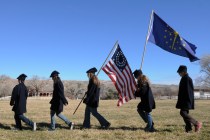Goodsprings stays true to its pioneer past
A quiet little community nestled against desert hills less than 40 miles south of Las Vegas, Goodsprings preserves a pioneer past and laid-back lifestyle far different from its glittering urban neighbor. Visitors to the former mining boomtown take a trip into Nevada's past when they follow a 10-stop walking or driving tour outlined by the Goodsprings Historical Society, accessible at goodsprings.org.
To reach Goodsprings, head south on Interstate 15 a little more than 30 miles to the freeway exit at Jean onto Highway 161. Follow this paved route seven miles west to Goodsprings, home to a couple of hundred hardy folks.
The highway parallels the roadbed of the Yellow Pine Railroad, a long-dismantled narrow gauge railway built in 1911 to connect Goodsprings with the main rail line at Jean. The town's cemetery lies on the right a half-mile from Goodsprings. The last resting place of several Goodsprings residents prominent in the history of early Southern Nevada, the cemetery has served Goodsprings since 1890. Ruins of the Yellow Pine Mill lie just beyond on the left. Once the throbbing heart of Goodsprings' prosperity as it processed ore from area mines, the mill today is marked only by foundations, its machinery stilled long ago.
Goodsprings has a long history. Natural springs attracted early native people on food-gathering and hunting forays. While establishing the overland trading and travel route known as the Old Spanish Trail, Antonio Armijo and 60 men camped there in 1830. The earliest Mormon settlers at Las Vegas mined lead not far away at Mount Potosi in 1857.
The springs acquired a new name after cattleman Joseph Good settled there in 1861 and discovered silver ore. Good is credited with planting cottonwood trees at moist areas in the vicinity, giving rise to the stands of shade trees that now characterize the desert town.
Silver-lead discoveries there in 1868 sparked some interest, but the discovery of gold ore in the 1890s set off a boom. A busy mining district with many claims and mines soon developed. In 1901, many of these endeavors were consolidated into the Yellow Pine Mining Company. The town that grew up to meet the needs of miners and their families soon included a variety of businesses, seven saloons, a 20-room hotel, a hospital, a school and a post office.
During World War I, Goodpsprings' mines helped meet wartime needs for lead and zinc. During Goodsprings' heyday in 1916-1917, about 800 people lived there. The mining district around Goodsprings ultimately became Clark County's heaviest producer, yielding $31 million over several decades.
Despite the ravages of fire and time, several historic buildings still stand in Goodsprings, all noted on the historical tour. The oldest building in town is a rustic stone cabin constructed in 1886. A weathered wooden cabin by a venerable cottonwood dates from 1910. Originally housed in a tent, Goodsprings' schoolhouse was erected in 1913. In 1916, two classrooms were added to the back. It stands now as Clark County's oldest school building still in use.
Of the seven original saloons, only the Pioneer Saloon remains. Built in 1913, its interior and exterior walls are covered in the original pressed tin. It retains original gaming tables, a potbellied stove that is a veteran of many winters and a handsome cherry wood bar moved to Goodsprings from Rhyolite. Photos, clippings, mementos and relics of yesteryear displayed in the Pioneer trace a century of the town's history.
Among the most poignant are the news stories and photos of actor Clark Gable, who waited in the Pioneer for word of his beautiful actress wife, Carole Lombard, after a plane crash on Mount Potosi in 1942.
The walking tour does not mention one of Goodsprings' most enduring pioneers. If you visit this month, watch for the fragrant yellow blossoms of a briar rose that came with settlers to the frontier. Hybridized in 1830 in New York by George Folliott Harison, a lawyer and horticulturist, the hardy Harison's (or Harrison's) Yellow rapidly gained popularity. It grows well from cuttings, so pioneers took pieces of it home with them on the emigrant trails. Abandoned on farms and in ghost towns across the West, the rose persists on its own in true pioneer style.
Margo Bartlett Pesek's columns appears on Sundays.

















